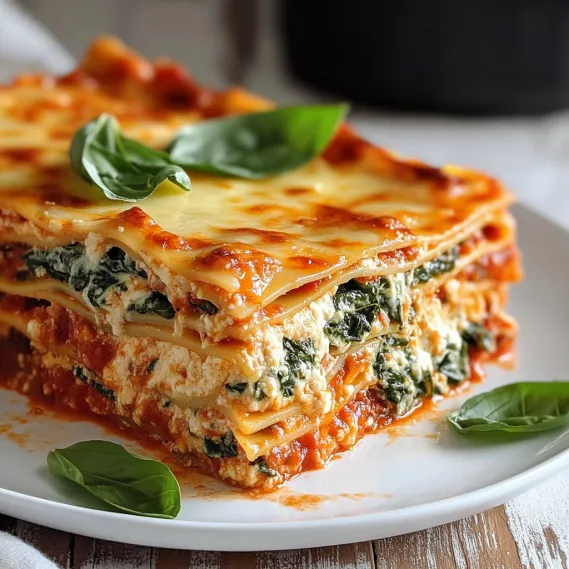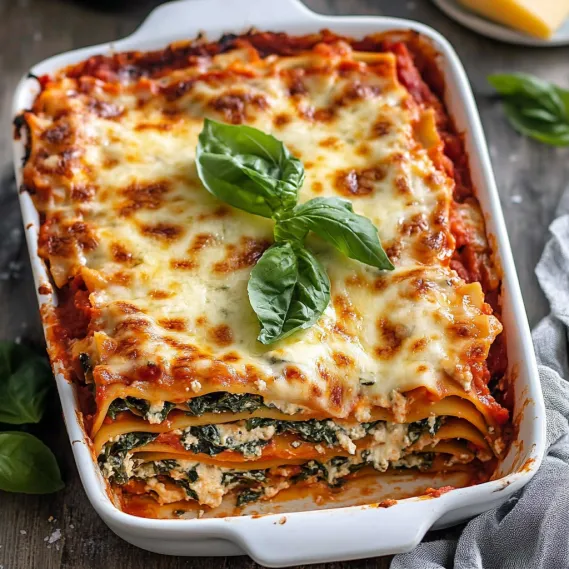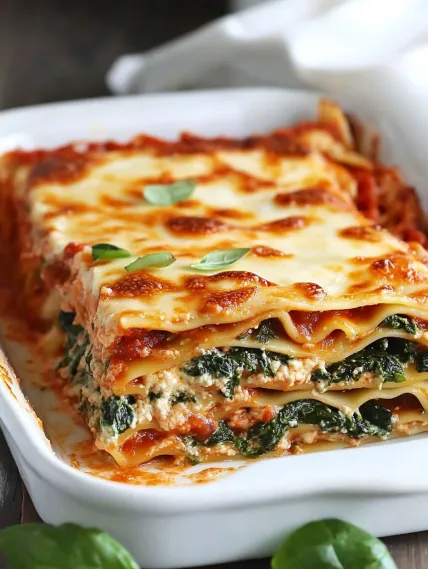 Pin
Pin
This ultimate spinach lasagna combines three cheeses with vibrant greens for a hearty Italian classic that's impressive enough for Sunday dinner yet simple enough for weeknight meals. The combination of creamy ricotta, gooey mozzarella, and nutty Parmesan creates irresistible layers that will satisfy everyone at your table.
I first made this lasagna when hosting my Italian mother in law for dinner, and it's now become our go to comfort food. She actually asked for the recipe, which I consider the ultimate culinary compliment!
Ingredients
- Fresh lasagna sheets: Save precious cooking time and create a silkier texture
- Marinara sauce: Provides the acidic base that balances the richness of the cheeses
- Frozen spinach: Offers convenience while adding essential nutrients and beautiful color
- Ricotta cheese: Creates the creamy foundation of the filling with its milky sweetness
- Parmesan cheese: Brings the umami punch and depth of flavor only aged cheese can deliver
- Mozzarella cheese: Provides that stretchy pull and golden brown top that makes lasagna irresistible
How To Make Ultimate Spinach Lasagna
- Prepare the mozzarella:
- If working with fresh mozzarella, slice it thinly and place on paper towels. This step is crucial because excess moisture can make your lasagna watery. Let it rest while preparing other components to draw out as much liquid as possible.
- Prepare the spinach:
- Thoroughly thaw frozen spinach and squeeze repeatedly to remove all excess moisture. I recommend using clean kitchen towels or cheesecloth for maximum liquid extraction. Properly drained spinach ensures your filling stays thick and flavorful.
- Mix the filling:
- Combine your drained spinach with ricotta and most of the Parmesan in a large bowl. Season generously with salt and black pepper. This is where your lasagna gets its personality, so taste and adjust seasonings until it sings. The filling should be rich and well seasoned.
- Prepare the oven and pasta:
- Heat your oven to 200°C while preparing the pasta. If using dry lasagna sheets, cook them until slightly underdone as they will continue cooking in the oven. Fresh pasta needs no precooking and goes directly into the assembly.
- Start the assembly:
- Begin with a thin layer of marinara sauce on the bottom of your baking dish. This prevents sticking and adds moisture to the bottom pasta layer. Spread it evenly across the entire surface for consistent results.
- Build the first layer:
- Place lasagna sheets over the sauce layer, slightly overlapping if necessary. Then add more sauce, followed by the spinach ricotta mixture and a light sprinkle of mozzarella. Press gently to create an even layer without gaps.
- Create multiple layers:
- Continue building your lasagna with the same sequence of ingredients, creating three or four distinct layers. Maintain consistent thickness in each layer for even cooking and a beautiful presentation when sliced.
- Top and finish:
- For the final layer, place pasta sheets on top, cover with remaining sauce, and finish with a generous blanket of both remaining cheeses. The top layer should be slightly more cheese heavy to create that beautiful golden crust.

The Parmesan cheese is truly the secret weapon in this recipe. I always grate it fresh rather than using pre grated varieties which contain anti caking agents. The difference in flavor is remarkable and creates that authentic Italian taste that makes this lasagna so special.
Perfect Pairings
This spinach lasagna pairs beautifully with a simple arugula salad dressed with lemon and olive oil. The peppery greens and bright acidity cut through the richness of the cheese. For a complete meal, serve with garlic bread to soak up any extra sauce and a medium bodied Italian red wine like Chianti or Montepulciano.

Storage and Reheating
This lasagna actually improves with time as the flavors meld together. Store leftovers covered in the refrigerator for up to 4 days. For best results when reheating, let it come to room temperature for 20 minutes, then warm in a 350°F oven until heated through about 20 minutes. Microwaving works in a pinch but can make the pasta slightly chewy.
Ingredient Substitutions
If you are looking to lighten this dish, cottage cheese can replace some or all of the ricotta with a slight texture change. For a dairy free version, cashew cream can substitute for ricotta, and nutritional yeast provides a similar flavor to Parmesan. Fresh spinach can replace frozen simply sauté 2 pounds of fresh spinach until wilted, cool, and squeeze dry before using.
Historical Context
Lasagna has ancient roots dating back to Roman times, though the version we recognize today evolved in Naples during the Middle Ages. Traditional Italian lasagne varies by region with northern versions featuring béchamel sauce while southern Italian recipes like this one rely on tomato sauce. This spinach lasagna represents a perfect vegetarian adaptation of classic southern Italian cooking techniques.
Recipe FAQs
- → Can I use fresh spinach instead of frozen?
Yes, you can substitute fresh spinach. Sauté it briefly to wilt, then drain and chop before mixing with the ricotta.
- → What type of mozzarella works best?
Both fresh and shredded mozzarella work well. Fresh adds creaminess, while shredded offers convenient melting.
- → How do I prevent a watery lasagna?
Ensure spinach is thoroughly drained and use paper towels to remove excess moisture from fresh mozzarella.
- → Can I make this lasagna ahead of time?
Absolutely! Assemble the lasagna, cover it tightly, and refrigerate for up to 24 hours before baking.
- → What side dishes pair well with this lasagna?
A simple green salad, garlic bread, or roasted vegetables make great accompaniments to this dish.
- → Can I freeze leftover lasagna?
Yes, let it cool completely, then portion and freeze. Reheat in the oven for the best texture.
